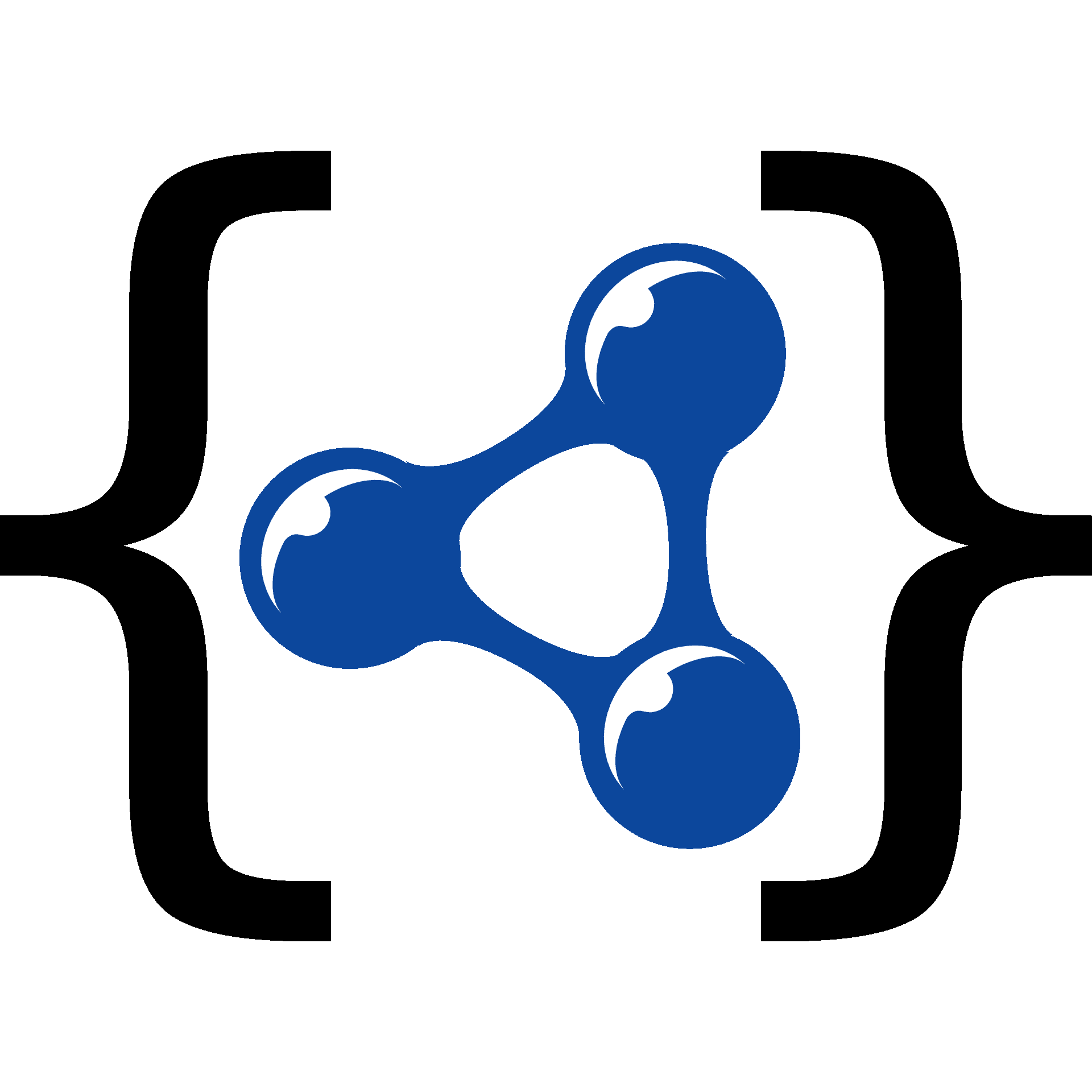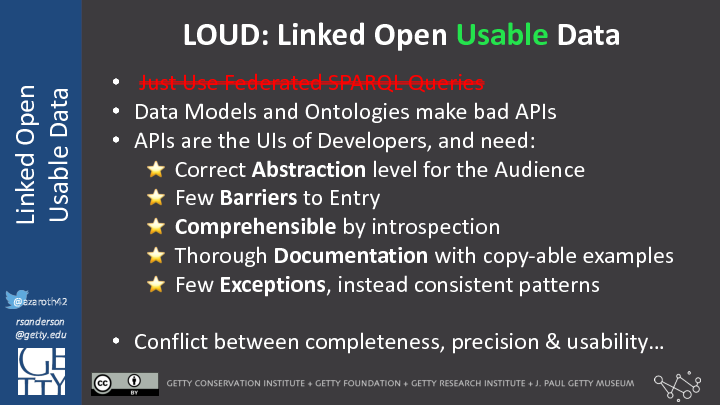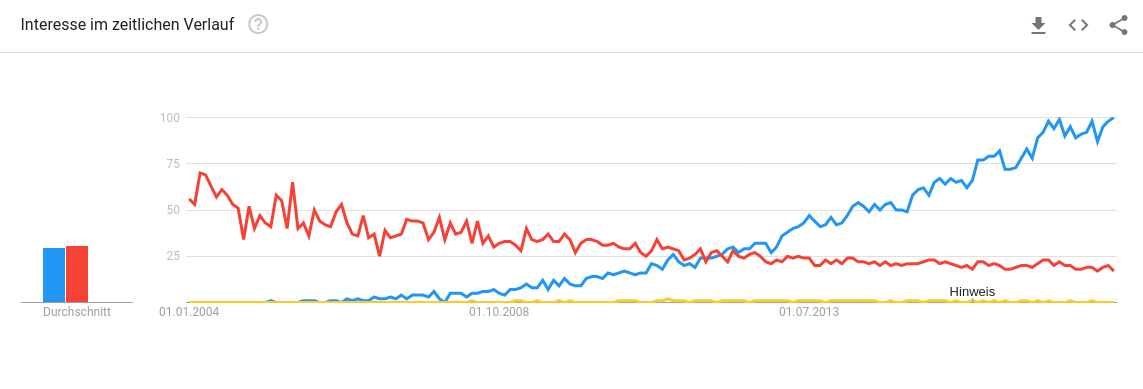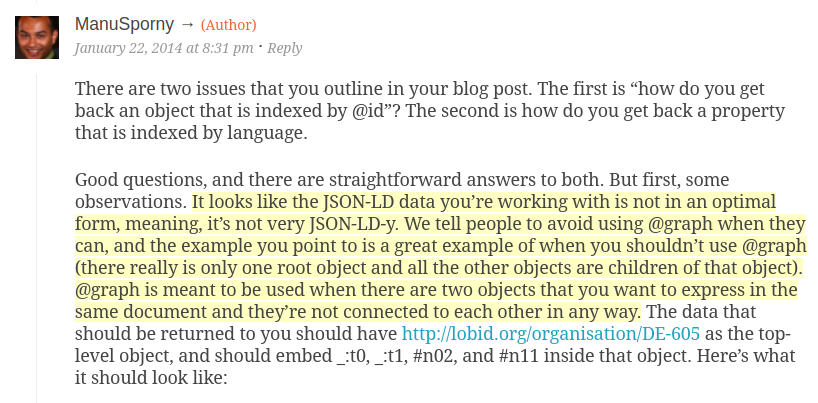JSON-LD – Einführung und Anwendungen
Session beim DINI-KIM-Workshop 2018
Adrian Pohl /
@acka47
Linked
Open Data, Hochschulbibliothekszentrum NRW (hbz)

Mannheim, 2018-04-10
Diese Präsentation:
http://slides.lobid.org/kim-ws-2018/

Agenda
- Zur Entstehung
- Das Format
- Erfahrungen mit lobid & JSON-LD
- JSON Schema & JSON-LD
- Ausblick
1. Zur Entstehung

RDF, SPARQL, Semantic Web –
Not in my backyard!
RDF isn't natural — and therefore is barely used — by the average Web developer or data wrangler. CSV [and JSON], by contrast, is. And you are going to need to win the hearts and minds of those folks for whatever approach is proposed.
– Rufus Pollock, 2013 (siehe hier & hier)
Vom Semantic Web...
Stop mentioning RDF and the Semantic Web.
Focus on tools for developers.
Do more dogfooding.
– Manu Sporny, 2012, beim Schreiben an der JSON-LD Spec (Quelle)...zu Linked Data...
Ultimately, RDF and the Semantic Web are of no interest to Web developers. They also have a really negative public perception problem. We should stop talking about them. Let’s shift the focus to be on Linked Data, explaining the problems that Web developers face today, and concrete, demonstrable solutions to those problems.ebd.
...bis Linked Open Usable Data

Quelle: Rob Sanderson, "Publishing & Retrieving Linked Open Usable Data", CC-BY
JSON(-LD) erobert das Web

xml api json api sparql endpoint
10 % bis 19 % aller Domains haben eingebettetes JSON-LD
Quellen: Google Trends, Web Data Commons, W3Techs2. Das Format
JSON – JavaScript Object Notation
Ein einfaches, lesbares Key-Value-Format für strukturierte Daten
Key = String in Anführungszeichen
Values = object, array, number, string oder boolean
{ "foo": "bar" }
JSON
$ curl -H "Accept: application/json" https://api.github.com/users/acka47
{
"login": "acka47",
"avatar_url": "https://avatars2.githubusercontent.com/u/160292?v=4",
"url": "https://api.github.com/users/acka47",
"type": "User",
"name": "Adrian",
"company": "hbz",
"location": "Cologne, Germany",
"bio": "Metadata, RDF, vocabularies. Working at @hbz. "
}
JSON + @context = JSON-LD
{
"@context": {
"schema": "http://schema.org/",
"login": "schema:alternateName",
"avatar_url": "schema:image",
"url": "schema:url",
"type": "@type",
"User": "schema:Person",
"name": "schema:name",
"company": "schema:worksFor",
"location": "schema:homeLocation",
"bio": "schema:description"
},
"login": "acka47",
"avatar_url": "https://avatars2.githubusercontent.com/u/160292?v=4",
"url": "https://api.github.com/users/acka47",
"type": "User",
"name": "Adrian",
"company": "hbz",
"location": "Cologne, Germany",
"bio": "Metadata, RDF, vocabularies. Working at @hbz. "
}
Formen von JSON-LD
Expanded Document Form: Ohne @context (d.h. alle URIs immer ausgeschrieben) und Values immer in Array
Compacted Document Form: Mit @context
Flattened Document Form: Mit @context und @graph und alle Objekte ungeschachtelt auf einer Ebene
JSON-LD Keywords
@context mappt Strings für Properties & Klassen auf URIs
@id identifiziert die URI eines Nodes (das Subjekt)
@type ist multifunktional: legt 1.) die Klasse eines nodes (rdf:type) fest oder 2.) den Datentyp eines Literals oder kann 3. für type coercion genutzt werden
Sonstige: @value, @language, @container, @list, @set, @reverse, @index, @base, @vocab, @graph
Keine @id?
{
"@context": {
"schema": "http://schema.org/",
"login": "schema:alternateName",
"avatar_url": "schema:image",
"url": "schema:url",
"type": "@type",
"User": "schema:Person",
"name": "schema:name",
"company": "schema:worksFor",
"location": "schema:homeLocation",
"bio": "schema:description"
},
"login": "acka47",
"avatar_url": "https://avatars2.githubusercontent.com/u/160292?v=4",
"url": "https://api.github.com/users/acka47",
"type": "User",
"name": "Adrian",
"company": "hbz",
"location": "Cologne, Germany",
"bio": "Metadata, RDF, vocabularies. Working at @hbz. "
}
JSON + @context = JSON-LD
{
"@context": {
"schema": "http://schema.org/",
"login": "schema:alternateName",
"avatar_url": "schema:image",
"url": "schema:url",
"type": "@type",
"User": "schema:Person",
"name": "schema:name",
"company": "schema:worksFor",
"location": "schema:homeLocation",
"bio": "schema:description"
},
"@id": "https://api.github.com/users/acka47#!",
"login": "acka47",
"avatar_url": "https://avatars2.githubusercontent.com/u/160292?v=4",
"url": "https://api.github.com/users/acka47",
"type": "User",
"name": "Adrian",
"company": "hbz",
"location": "Cologne, Germany",
"bio": "Metadata, RDF, vocabularies. Working at @hbz. "
}
Aufgabe (5 min):
Schreibe einen @context
http://tinyurl.com/ya3ydscw
3. Erfahrungen mit lobid & JSON-LD
lobid-Erfahrungen mit JSON-LD seit 2013
Konversion von RDF mit JSON-LD Java Library führt zu suboptimalem Ergebnis, vor allem:
Flaches JSON, mit mehreren Nodes in @graph-Objekt
lobid 1.x
{
"@id" : "http://lobid.org/organisation/DE-180/about",
"primaryTopic" : "http://lobid.org/organisation/DE-180",
"@graph": [ {
"@context" : "http://lobid.org/context/lobid-organisations.json",
"@id" : "http://lobid.org/organisation/DE-180",
"name" : "Universitätsbibliothek Mannheim",
"stocksize" : "http://purl.org/lobid/stocksize#n10",
"address" : "_:t3"
}, {
"@id" : "_:t3",
"countryName" : "Germany",
"locality" : "Mannheim",
"postalCode" : "68131",
"streetAddress" : "Schloss Schneckenhof West"
}, {
"@id" : "http://purl.org/lobid/stocksize#n10",
"prefLabel" : [ {
"@language" : "de",
"@value" : "1.000.001 und mehr"
}, {
"@language" : "en",
"@value" : "1,000,001 and more"
} ]
} ]
}
Not very JSON-LD-y

Quelle: http://manu.sporny.org/2014/json-ld-origins-2/#comment-4190
Weitere Probleme mit lobid-RDF zu JSON-LD Konversion
Wenn Node zweimal auftaucht wird Beschreibung nur einmal eingebettet
Mängel bei der Erzeugung von Arrays mit gemischten Inhalten
Index- und Auslieferungsformat unterscheiden sich (extended vs. flattened)
...plus ein paar Dinge, die ich vergessen habe
lobid 2.x-Neuerungen
Selbst geschriebenes Java-Tool zur Generierung von JSON-LD (GitHub)
Aliasse für @type und @id (best practice)
Labels für alle Nodes ergänzen mit etikett
Language maps für mehrsprachige Labels
Identisches Index- und Auslieferungsformat
Verbesserte Datenmodellierung (mehr Bibframe, schema.org...)
lobid 2.x
{
"@context" : "http://lobid.org/organisations/context.jsonld",
"id" : "http://lobid.org/organisations/DE-180#!",
"name" : "Universitätsbibliothek Mannheim",
"location" : [ {
"type" : "Place",
"address" : {
"postalCode" : "68131",
"streetAddress" : "Schloss Schneckenhof West",
"addressLocality" : "Mannheim",
"addressCountry" : "DE",
"type" : "PostalAddress"
},
"geo": {
"lat": "49.48309",
"lon": "8.46362"
}
} ],
"collects" : {
"type" : "Collection",
"extent" : {
"id" : "http://purl.org/lobid/stocksize#n10",
"type" : "Concept",
"label" : {
"de" : "1.000.001 und mehr",
"en" : "1,000,001 and more"
}
}
}
}
Aufgabe (5-10 min):
Schachtele das JSON und entferne das @graph-Objekt
http://tinyurl.com/y9wnft4j
4. JSON Schema & JSON-LD
JSON Schema & JSON-LD
Wenn man JSON-LD als zentrale RDF-Serialisierung benutzt, bietet sich JSON Schema zur Validierung an
Ist näher an der Serialisierung, leichter verständlich und besser unterstützt als SHACL oder ShEx
Einsatz in der OER World Map zur Validierung der Eingabe (POST)
(Noch einfacher les- und schreibbar ist GraphQL Schema Language, die für zukünftige Implementierungen in Betracht kommt.)
Application Profiles mit JSON Schema entwickeln?
Mögliche Properties und Constraints finden -> in Schema schreiben -> in Editor testen -> Diskussion -> von vorne
JSON-Schema-basierter Metadateneditor von Felix Ostrowski: http://graphthinking.com/jpf/
JSON-Schemas für OER-Metadaten: https://github.com/dini-ag-kim/oer-metadata-schemas
Nachteil: abhängig von bestimmter Umsetzung einer bestimmten RDF-Serialisierung & damit nicht für andere Implementierungen als Referenz nutzbar
5. Ausblick
JSON-LD 1.1
Ein Update der JSON-LD-Spezifikation ist im Gange.
Motto: Keys not Arrays! Framing!
Mehr Details: Präsentationsfolien von Gregg Kellog & Rob Sanderson zu JSON-LD 1.1
Das war's!
Zum Schluss noch ein paar mehr Aufgaben, für's Büro oder falls jetzt noch Zeit bleibt.
Weitere Aufgaben
- Sprach-Tagging von Strings I: http://tinyurl.com/yd6k6tz7
- Datentypen: http://tinyurl.com/y8x2xnld
- Mehr Datentypen: http://tinyurl.com/ybws3s6n
- Arrays erzwingen: http://tinyurl.com/y9smp5aw
- Datenverschönerung: http://tinyurl.com/yafqgs3y
- Aliasse: http://tinyurl.com/yapukz8k
- Language Maps: http://tinyurl.com/yc9xtzal
- Framing: http://tinyurl.com/yatu7ht9
Dank an:
Rob Sanderson für seine Vortragsfolien, die mir für einige Slides als Vorlage dienten.
Rurik Greenall für seinen JSON-LD-Kurs: https://github.com/brinxmat/json-ld-course, dessen Aufgaben ich als Vorlage genommen habe.